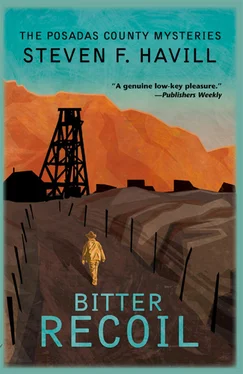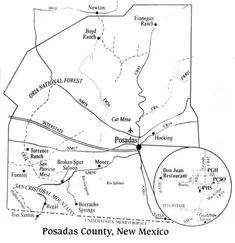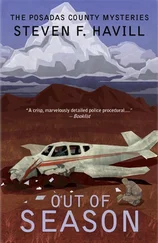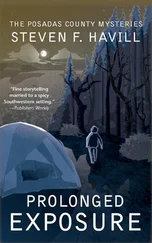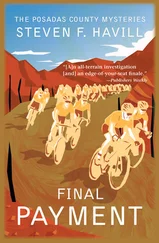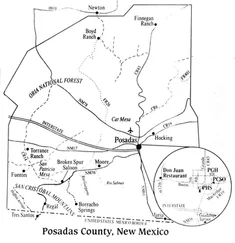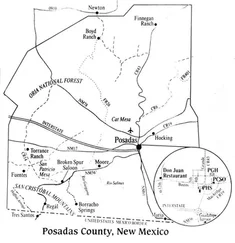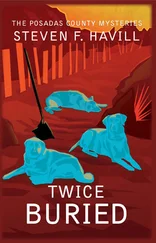Steven Havill - Bitter Recoil
Здесь есть возможность читать онлайн «Steven Havill - Bitter Recoil» весь текст электронной книги совершенно бесплатно (целиком полную версию без сокращений). В некоторых случаях можно слушать аудио, скачать через торрент в формате fb2 и присутствует краткое содержание. Год выпуска: 2011, ISBN: 2011, Издательство: Poisoned Pen Press, Жанр: Полицейский детектив, на английском языке. Описание произведения, (предисловие) а так же отзывы посетителей доступны на портале библиотеки ЛибКат.
- Название:Bitter Recoil
- Автор:
- Издательство:Poisoned Pen Press
- Жанр:
- Год:2011
- ISBN:9781615950751
- Рейтинг книги:3 / 5. Голосов: 1
-
Избранное:Добавить в избранное
- Отзывы:
-
Ваша оценка:
- 60
- 1
- 2
- 3
- 4
- 5
Bitter Recoil: краткое содержание, описание и аннотация
Предлагаем к чтению аннотацию, описание, краткое содержание или предисловие (зависит от того, что написал сам автор книги «Bitter Recoil»). Если вы не нашли необходимую информацию о книге — напишите в комментариях, мы постараемся отыскать её.
Bitter Recoil — читать онлайн бесплатно полную книгу (весь текст) целиком
Ниже представлен текст книги, разбитый по страницам. Система сохранения места последней прочитанной страницы, позволяет с удобством читать онлайн бесплатно книгу «Bitter Recoil», без необходимости каждый раз заново искать на чём Вы остановились. Поставьте закладку, и сможете в любой момент перейти на страницу, на которой закончили чтение.
Интервал:
Закладка:
“Maybe,” I said. “But if someone gets nailed by a car hard enough to toss ’em down a goddamned cliff onto rocks, I can’t believe they’d survive, much less be able to crawl so far.”
“That’s what bothers me,” Estelle said. “Maybe we’ll be able to piece something together when we have the medical report.”
“She didn’t have any identification?”
“None.”
“Terrific.” I looked at my watch. It was already quarter of five. “What now?”
“I want to walk down along the road and see if I come up with anything. And then up the other way. By then it’ll be dawn and we can see what we missed.”
“What do you want me to do?”
“You’re on vacation, sir.”
“Pretend I’m not. I had a couple hours of vacation yesterday. That was probably enough.”
Estelle smiled and shook her head. “Maybe you’d go down to San Estevan, where they took the girl. She’ll go to the clinic there first and no doubt be transferred to Albuquerque. You might be able to find something out there.”
I nodded. “Invitation for dinner still on for tonight?”
“Of course.” She slammed the trunk closed. “By then this’ll be all wrapped up.”
Estelle Reyes-Guzman wasn’t wrong too often.
Chapter 3
By the time I reached the public health clinic in San Estevan, the victim had been airlifted to Albuquerque. The EMTs in the ambulance had been quick-witted and efficient. They knew that the extent of the girl’s injuries was more than the clinic could handle. The helicopter air ambulance, a Bell Jet Ranger, had been dispatched from the city and made the roundtrip flight before I left the mountain.
As I drove into the village at six in the morning, San Estevan was beginning the rooster and barking dog stage of awakening. I drove past the Catholic retreat complex north of the village and caught sight of one friar or monk or whatever he was, as he crossed from one white adobe building to another, toiletry kit in hand.
A hundred yards beyond and on the opposite side of the road was a National Park Service historic site, the restoration of Gualate Ruin, a two-story stone structure that I’d heard was one of the dozens of outliers for the major ruin at Chaco Canyon to the west.
None of the feds were up yet, nor was there life stirring at the Forest Service District Office, a low, flat building tucked in the cottonwoods where the state highway turned away from the river and into the village.
No more than two dozen houses, scattered here and there across the narrow valley, made up the ancient village of San Estevan. Originally, the town had sprung up on the edge of the Indian pueblo, a mixture of clergy, traders, and farmers.
A few of the houses were massive, with adobe walls a yard thick and large courtyards-architecture that said there’d been some rich times in the valley.
But the inevitable was happening. The village was just outside the pueblo’s reservation, and so the valley was salted now with crackerbox shacks and trailers, bright aluminum mobile homes insulting the stolid, ancient adobes as city folk established their weekend camps and “ranchettes,” as the realtors say.
If I drove a thousand yards south of the village’s gas station, south of the modern clutter and detritus of seasonal residents, I could imagine that a century had been peeled away.
The pueblo, one of the state’s smallest, was neat and uniformly reddish-brown. Burnt sienna adobes with mud ovens in every yard, neat stacks of piNon and juniper firewood behind every dwelling, narrow brown lanes packed hard as cement between the houses, all leading down to the brown-trunked cottonwoods that screened the river from view.
The demarcation between pueblo land and private land beginning with the village of San Estevan was as obvious as if there were a solid wall between the two.
I passed the Texaco station and, where the highway jogged another right angle turn, the combination of Dairy Queen and general store. Just beyond, a group of three trailers was parked willy-nilly to form a compound filled with wrecked car and truck carcasses, and beyond those was a fenced pasture where two horses grazed themselves fat.
Remembering Estelle’s directions, I looked for the sign and found it nearly camouflaged by purple bee-weed. Below the sign for the San Estevan Clinic, United States Public Health Service, an arrow pointed to a graveled lane.
I pulled into the clinic’s driveway and parked beside a blue Isuzu Trooper with Posadas County plates. No matter where they moved in the state, Estelle and Francis Guzman would carry that tag until it rusted to pieces…a gentle reminder of their home to the south.
Only one other vehicle was in the lot, an older model GMC pickup-maybe a ’55 or ’56. It was no collector’s item, though, just an aging, battered work truck.
I crushed out my cigarette and walked inside the building. The clinic was cramped, with a twelve-by-twelve waiting room, a tiny cell for the receptionist, and a narrow hallway that led back to the treatment rooms. I guessed there were two of those at the most. I heard a metal pan clatter and voices, and then an Indian woman stuck her head out of one of the examining room doors. She saw me and held up a hand with one finger raised.
“I’ll be right out,” she said and disappeared again. I turned, looked around the waiting room, and saw universal doctor’s office decorations…aging magazines, a few children’s books. A large Ojo de Dios woven out of gaudy yarn hung on one wall and a sand painting of an Indian dancer in an awkward pose on another.
Across the room on the west wall was a framed state map with a large water stain rumpling all of Colfax, Mora, San Miguel, and Guadalupe counties. Beside the map was a framed aerial photograph of a mountain in fall colors, aspens aflame. It was no local mountain, of course…probably one from Colorado or Wyoming-wherever the postcard artist had been able to find a nice, conical, generic mountain with no towns, powerlines, or highways to mar the picture.
I stepped to the window and looked out at chamiso, cactus, and rocks.
“May I help you?”
I turned quickly. The nurse had a pencil and metal clipboard poised at the ready. She was older than I had first thought. Steel gray was beginning to temper her ebony hair, tied back tightly in a bun. Her black eyes regarded me calmly from a broad, flat face whose flawless skin was like burnished walnut. I read the name tag on her white blouse and wondered how long Mary Vallo had been an R.N. She might have been forty years old or sixty-five.
“Good morning, Mrs. Vallo,” I said. “I’m Bill Gastner, undersheriff of Posadas County, down in the southern part of the state. I’ve been assisting Deputy Guzman with an accident investigation this morning.” I started the standard smoker’s fumble for a cigarette and thought better of it. “I wondered if I could talk with Dr. Guzman for a minute, if he’s not tied up.”
“Surely,” Mary Vallo said. “Come on back.” She led the way down the hall, and in one small cubbyhole I saw a coffee maker just beginning to drip. Sharp-eyed Mary saw my glance and said, “I just started it. I’ll get you a cup as soon as it’s ready.”
“Wonderful,” I said, feeling about three hours overdue for my first morning caffeine buzz.
The examining room we entered was small and the scene of considerable recent action. Mary Vallo resumed her labors, at that moment cleaning the spatters from the front of the portable X ray unit. Francis Guzman was sitting at a table by the window awash with paperwork. His white smock was white in small spots only. He glanced up, not eager to move.
“Well, I’ll be damned!” the young physician exclaimed, and he pushed himself away from the table, extending a hand to me at the same time. “You’re about the last person I expected to see at this hour. How have you been, Sheriff?”
Читать дальшеИнтервал:
Закладка:
Похожие книги на «Bitter Recoil»
Представляем Вашему вниманию похожие книги на «Bitter Recoil» списком для выбора. Мы отобрали схожую по названию и смыслу литературу в надежде предоставить читателям больше вариантов отыскать новые, интересные, ещё непрочитанные произведения.
Обсуждение, отзывы о книге «Bitter Recoil» и просто собственные мнения читателей. Оставьте ваши комментарии, напишите, что Вы думаете о произведении, его смысле или главных героях. Укажите что конкретно понравилось, а что нет, и почему Вы так считаете.
